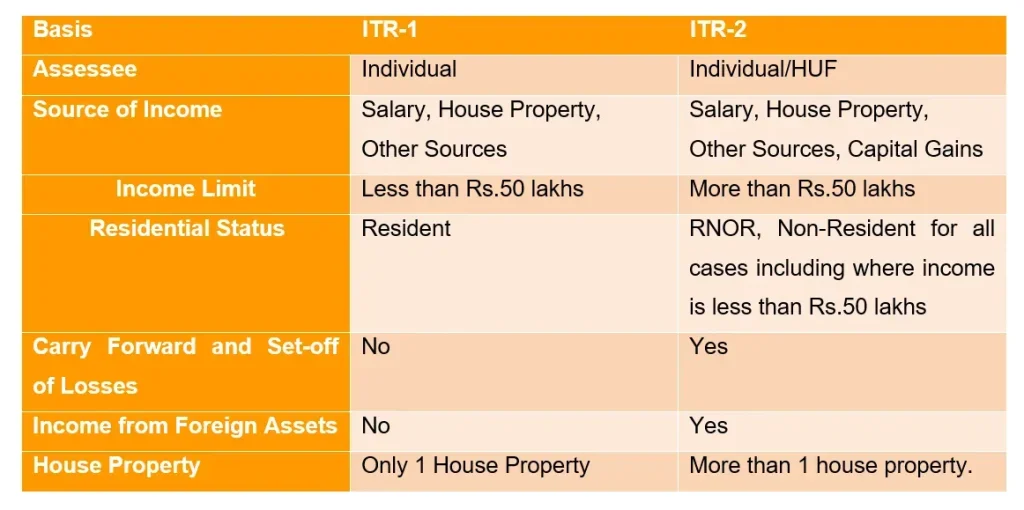When it comes to filing income tax returns, a common dilemma emerges among taxpayers: ITR-1 vs ITR-2. These two forms cater to different income levels and types, making it crucial for individuals to choose wisely to avoid pitfalls such as return rejection or delayed refunds. The ITR-1 form, often referred to as Sahaj, is tailored for those with a total annual income up to ₹ 50 lakh and specific income sources, while ITR-2 accommodates individuals earning above ₹ 50 lakh or with more complex income profiles. Understanding the eligibility criteria for these forms can simplify your tax filing process significantly, allowing you to file ITR efficiently and correctly. In this guide, we will explore key differences between the ITR-1 and ITR-2 forms, offering clarity on taxpayer eligibility, income sources, and more.
Navigating through the intricacies of income tax filing can be overwhelming, particularly when distinguishing between the different forms available. The forms that taxpayers often encounter—specifically the ITR-1 (Sahaj) and ITR-2—serve distinct purposes and are intended for individuals with varying income brackets and situations. ITR-1 is typically designed for salaried individuals with simpler income structures, while ITR-2 suits those who have larger incomes or diverse sources of income including capital gains. By assessing your financial situation and understanding the requirements associated with these forms, you can ensure compliance while maximizing your benefits when filing your income tax returns.
Understanding ITR-1: A Comprehensive Overview
Form ITR-1, also known as the Sahaj tax return form, is tailored primarily for individual taxpayers with a straightforward income structure. This form is ideal for salaried individuals whose total annual income does not exceed ₹ 50 lakh. By using the ITR-1 form, these taxpayers can easily report income from salary, house property, and other relatively simple sources such as interest from savings accounts. Furthermore, ITR-1 allows taxpayers to declare long-term capital gains, albeit only up to ₹ 1.25 lakh under Section 112A, making it a fitting choice for those who meet these specific criteria.
However, it is crucial to understand taxpayer eligibility when filing the ITR-1 form. Individuals categorized as Non-Resident Indians (NRIs) or Resident Not Ordinarily Resident (RNOR) are not eligible to use ITR-1, especially if they have income from gambling, lottery, or are directors in a company. Moreover, the form becomes less suitable for individuals with complex financial situations, such as those with multiple house properties or significant capital gains beyond the stipulated limits.
Eligibility and Requirements for Form ITR-1
Taxpayers must genuinely assess their eligibility before opting for Form ITR-1 to avoid complications later. Apart from the income ceiling of ₹ 50 lakh, applicants should note that they can only declare income from a single house property, which can restrict those with real estate investments. Agricultural income can only be reported if it does not exceed ₹ 5,000, making this form less versatile for farmers or individuals with substantial agricultural earnings.
Moreover, understanding the ramifications of choosing the wrong income tax return form cannot be overstated. Filing ITR-1 when not eligible can lead to the outright rejection of the return, prolonging the process for receiving refunds and creating unnecessary penalties. Ultimately, it is advisable for individuals to seek clarity on their financial situation and consult a tax professional if there are uncertainties surrounding the use of ITR-1.
Delving into ITR-2: Who Should Choose This Form?
In contrast to ITR-1, Form ITR-2 is designed for individuals and Hindu Undivided Families (HUFs) who have a more complex income profile. This form is intended for taxpayers whose total annual incomes exceed ₹ 50 lakh and may include a variety of income sources, such as income from more than one property, agricultural income exceeding ₹ 5,000, or mixed income from investments, providing a broader scope for income declaration. Additionally, ITR-2 enables taxpayers to report both short-term and long-term capital gains, accommodating those with diverse financial portfolios.
Moreover, ITR-2 extends beyond the limitations placed on ITR-1 by allowing taxpayers to declare foreign income, ownership of unlisted shares, and additional investments. This ensures that individuals with a complex financial landscape can accurately and comprehensively report their earnings, aligning their obligations with the current income tax regulations. However, it is essential for applicants to remember that those engaged in business or professional income are not eligible for ITR-2, requiring careful consideration of the form’s applicability.
ITR-1 vs ITR-2: Key Differences Explained
Understanding the differences between ITR-1 and ITR-2 is vital for taxpayers when filing income tax returns. ITR-1 is better suited for those with straightforward income sources, including salaried individuals and taxpayers with limited capital gains. In contrast, ITR-2 caters to a wider range of individuals, including those with significant total incomes, multiple assets, and varied income streams. This distinction illustrates the importance of accurately assessing one’s financial situation to ensure compliance with tax regulations.
Importantly, the differences extend beyond income thresholds. For example, ITR-1 restricts taxpayers to declaring only one house property, while ITR-2 allows for reporting income from multiple properties. Such nuances are crucial in determining which tax return form best suits a taxpayer’s individual circumstances, influencing not only the filing process but also potential tax liabilities and refunds.
Common Mistakes to Avoid While Filing ITR
When filing income tax returns, taxpayers often overlook essential details that could affect their submission process. A common mistake includes failing to accurately assess their eligibility for the chosen ITR form, particularly regarding the transition between ITR-1 and ITR-2. Some taxpayers might mistakenly consider ITR-1 for their return, only to discover that their income surpasses the stipulated limits, leading to unnecessary complications and potential penalties.
Additionally, many taxpayers neglect to verify the source of their income accurately, especially if they derive earnings from multiple avenues or have assets like foreign income or capital investments. Such oversights not only jeopardize the smooth processing of the return but can also lead to questions or investigations from the Income Tax Department. Therefore, thorough documentation and consultation with a tax professional can mitigate these issues, ensuring a seamless filing experience.
Steps to File ITR Online
Filing income tax returns online has become increasingly convenient with advancements in digital platforms. To file ITR-1 or ITR-2, taxpayers first need to register on the Income Tax Department’s e-filing portal, which provides a user-friendly interface for navigating the tax filing process. After registration, individuals must select the appropriate ITR form based on their financial situation and proceed to fill in the required information, ensuring all income sources are accurately reported.
Additionally, before finalizing the submission, taxpayers should review all entries carefully to prevent errors that could delay processing. The online platform also offers options for e-verifying the return, which enhances efficiency and ensures that the return is accepted promptly. Keeping detailed records of income sources, tax deductions, and credits is essential for a successful online filing experience.
Understanding the Importance of Accurate Tax Reporting
Accurate tax reporting is crucial for maintaining compliance with the law and avoiding potential legal consequences. Taxpayers who take the time to carefully understand their obligations, including eligibility for forms like ITR-1 and ITR-2, are less likely to face issues such as audit inquiries or penalties from the Income Tax Department. Misreporting income can lead to unfavorable financial consequences, including delayed refunds or increased tax liabilities.
Furthermore, correctly completing income tax returns ensures that taxpayers can effectively manage their finances and make informed decisions in the future. Maintaining accurate tax records and adhering to the regulations provides taxpayers with peace of mind, knowing they have met their obligations and can benefit from legitimate tax advantages such as deductions and exemptions.
Impact of Taxpayer Eligibility on Filing
Taxpayer eligibility plays a significant role in the filing process of income tax returns. Each ITR form has specific eligibility criteria tailored to different income scenarios, which must be carefully followed to avoid complications. Understanding the differences between ITR-1 and ITR-2, for instance, helps establish which form is deemed appropriate based on the taxpayer’s financial circumstances, ensuring a smoother filing experience.
Moreover, being aware of ineligibility factors, such as types of income or the number of properties owned, assists taxpayers in choosing the correct ITR form. Failing to recognize these criteria can lead to unintended consequences, such as the rejection of the return or delayed processing of refunds. Therefore, taxpayers should thoroughly review their eligibility before proceeding with their filings, either independently or with professional guidance.
Seeking Professional Tax Assistance
Navigating through the complexities of income tax filings can be daunting for many taxpayers. Given the variations in eligibility criteria and the necessity of accurately reporting all income sources, seeking professional tax assistance can be a wise decision. Tax professionals can provide valuable guidance on which ITR form to use based on individual circumstances and ensure compliance with all regulatory requirements, minimizing potential pitfalls.
In addition, a tax professional can help identify applicable deductions and credits, which can significantly impact the overall tax liability. With their expertise, they can assist in preparing returns efficiently, ensuring that taxpayers submit error-free documentation and meet deadlines. Ultimately, investing in professional tax services can lead to a more manageable and beneficial tax filing experience for individuals and families alike.
Frequently Asked Questions
What are the main differences between ITR-1 and ITR-2 forms?
The key differences between ITR-1 and ITR-2 forms are based on income limits, type of income, and eligibility. ITR-1 is for individuals with a total income up to ₹ 50 lakh, whereas ITR-2 is for those with income over ₹ 50 lakh. Additionally, ITR-1 allows for one house property and limited agricultural income, while ITR-2 accommodates multiple properties and a broader range of income sources.
Who is eligible to file ITR-1 compared to ITR-2?
To file ITR-1, you must be a resident individual earning up to ₹ 50 lakh and having one house property and limited agricultural income. In contrast, ITR-2 is available to individuals and Hindu Undivided Families (HUFs) with incomes above ₹ 50 lakh, owning multiple house properties and having capital gains.
Can a taxpayer with capital gains file ITR-1?
A taxpayer with long-term capital gains of up to ₹ 1.25 lakh under section 112A can file ITR-1, provided they meet other eligibility criteria. However, if the capital gains exceed this limit or include short-term gains, the taxpayer must file ITR-2.
What kind of agricultural income is allowed in ITR-1 and ITR-2?
ITR-1 allows agricultural income up to ₹ 5,000, while ITR-2 accepts agricultural income exceeding ₹ 5,000. Therefore, if your agricultural earnings surpass this threshold, you will need to file ITR-2 instead of ITR-1.
Are NRIs eligible to file ITR-1 or ITR-2?
Non-Resident Indians (NRIs) are not eligible to file ITR-1 as it is limited to Resident individuals. NRIs may file ITR-2 if they have income from sources such as salary, property, or capital gains, assuming they have all necessary documentation.
What happens if I file the wrong ITR form, ITR-1 instead of ITR-2?
Filing the wrong Income Tax Return (ITR) form, such as ITR-1 instead of ITR-2, can lead to rejection of the return by the Income Tax Department, resulting in delays and complications with your tax filing process and refunds.
Can I also claim deductions while filing ITR-1?
Yes, while filing ITR-1, taxpayers can claim eligible deductions under sections like 80C, 80D, and others. However, the total income must not exceed the set limit, and the deductions should be compliant with the tax laws.
What are the consequences of filing ITR-2 for individuals who do not meet the criteria?
Filing ITR-2 without meeting eligibility criteria can lead to penalties or legal issues with the Income Tax Department. It’s essential to ensure that you fit the profile for ITR-2 before using this form to avoid complications.
When should a taxpayer choose ITR-2 over ITR-1?
Taxpayers should choose ITR-2 if they have an income exceeding ₹ 50 lakh, own multiple properties, possess capital gains, or have agricultural income beyond ₹ 5,000. These factors indicate that ITR-2 is the appropriate form for their financial situation.
| Feature | ITR-1 | ITR-2 |
|---|---|---|
| Income | Up to ₹ 50 lakh | Over ₹ 50 lakh |
| Applicant | Resident Individual | Resident or non-resident individuals and HUFs |
| Capital Gains | Long-term capital gains under section 112A up to ₹ 1.25 lakhs | Both short-term and long-term gains |
| Agricultural Income | Up to ₹ 5,000 | Over ₹ 5,000 |
| Income from Property | One house | More than one house |
Summary
When considering ITR-1 vs ITR-2, it’s crucial to understand that each form caters to different taxpayer profiles. ITR-1 is specifically designed for salaried individuals with simpler income streams, while ITR-2 accommodates a wider range of income sources, including property and capital gains, making it suitable for a broader audience. Filing the correct form is essential to avoid issues like tax return rejection or refund delays. Thus, taxpayers should carefully assess their income types and levels before choosing which ITR form to file.




